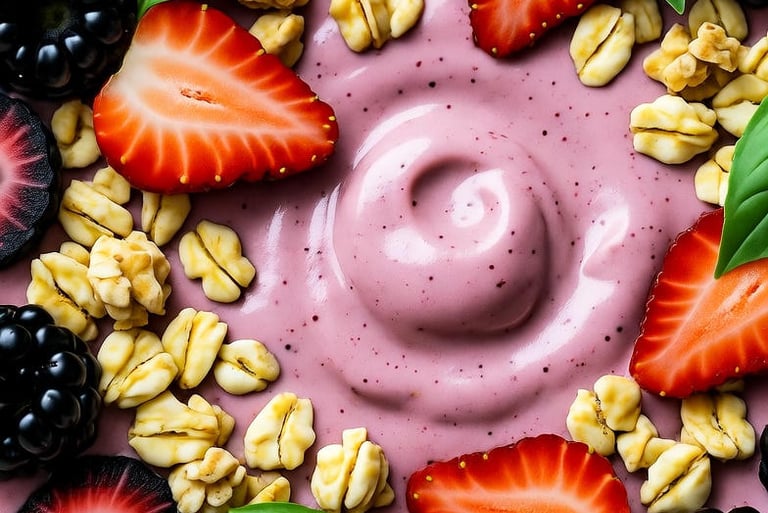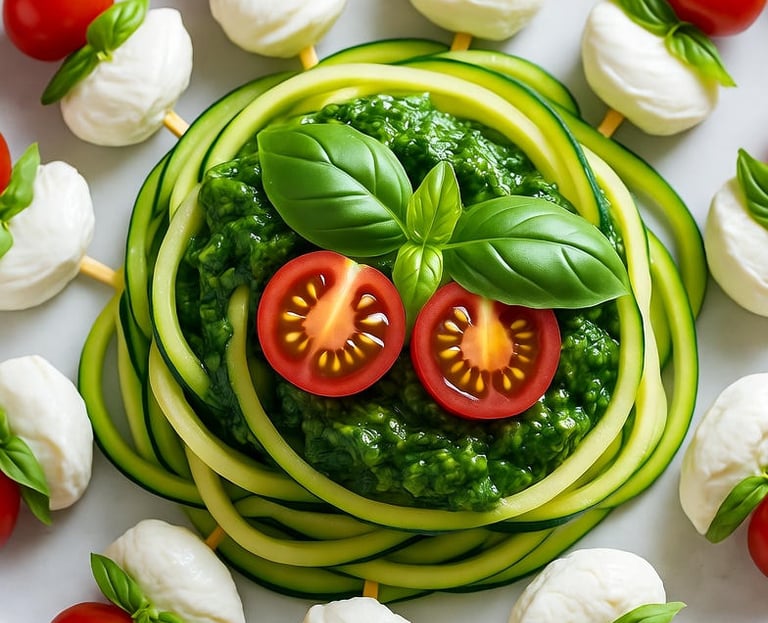Herbal Syllabus Series: "Basil"
Basil, with its fragrant leaves and versatile uses, is a beloved herb in kitchens worldwide, especially in Italian cuisine. Known for elevating dishes like pasta and pizza, basil also packs a nutritional punch with vitamins, minerals, and bioactive compounds that may support your health. Whether you’re tossing it into a salad or brewing a soothing tea, basil is a delightful addition to your daily routine.
10/5/20255 min read


Herbal Syllabus Series: "Basil"
Category: Nutritional Herbology Herb
Introduction
Basil, with its fragrant leaves and versatile uses, is a beloved herb in kitchens worldwide, especially in Italian cuisine. Known for elevating dishes like pasta and pizza, basil also packs a nutritional punch with vitamins, minerals, and bioactive compounds that may support your health. Whether you’re tossing it into a salad or brewing a soothing tea, basil is a delightful addition to your daily routine.
Top Properties
Vitamins: Rich in vitamins A, K, and C, supporting vision, blood clotting, and immunity.
Minerals: Contains calcium, iron, and magnesium for bone health and energy.
Antioxidants: Flavonoids and polyphenols combat free radicals.
Anti-inflammatory: Eugenol reduces inflammation in the body.
Antimicrobial: Essential oils fight bacteria and fungi.
Usage
Culinary: Fresh or dried leaves enhance salads, pasta, pizzas, and soups.
Tea: Steeped leaves create a soothing herbal tea.
Essential Oil: Used in aromatherapy or diluted for topical application.
Supplements: Available as capsules or extracts for concentrated benefits.
Effects on Main Bodily Systems
Nervous System: May improve memory, reduce depression, and enhance mental alertness (Healthline).
Cardiovascular System: Potentially lowers blood pressure and improves blood flow (WebMD).
Endocrine System: May help regulate blood sugar and cholesterol levels (Healthline).
Immune System: Antimicrobial properties support immune function (Medical News Today).
Digestive System: Aids digestion and reduces bloating (RxList).
Ways to Take It
Fresh Leaves: Add to salads, sandwiches, or as a garnish on dishes.
Dried Leaves: Use as a seasoning in cooking or baking.
Tea: Infuse 1-2 teaspoons of dried basil leaves in 1 cup of hot water for 5-10 minutes.
Essential Oil: Dilute with a carrier oil (e.g., coconut oil) for massage or use in a diffuser for aromatherapy.
Supplements: Follow dosage instructions on the product label, typically 500 mg capsules daily.
Detailed Information
Natural Properties: Basil (Ocimum basilicum) contains essential oils like eugenol, linalool, and citronellol, contributing to its aroma and therapeutic effects. These compounds offer antioxidant, anti-inflammatory, and antimicrobial benefits.
Effectiveness: Research suggests basil may reduce stress, support cardiovascular health, and combat bacterial infections. However, some medicinal uses lack robust scientific evidence, and large doses may pose risks due to estragole, a compound linked to liver cancer in high amounts (WebMD).
Where Found: Native to tropical Asia and Africa, basil is now cultivated globally in gardens, pots, or commercial fields. It thrives in warm, sunny climates with well-drained soil.
How to Harvest: Pick leaves as needed, starting from the top to encourage bushier growth. For larger harvests, cut stems just above a pair of leaves. Harvest before flowering for optimal flavor, typically in the morning after dew dries (Love and Lemons).
Detailed Explanation: Basil is an annual herb growing up to 2 feet tall, with green or purple leaves depending on the variety (e.g., sweet basil, Thai basil). It prefers full sun and regular watering. In culinary traditions, it’s a staple in Mediterranean and Asian dishes, while in herbal medicine, it’s used for its calming and digestive properties. Always consult a healthcare provider before using basil medicinally, especially if on blood-thinning or blood pressure medications.
1. Basil Pesto Zucchini Noodles
Description: A light, low-carb dish that combines the nutty, aromatic flavor of basil pesto with spiralized zucchini for a fresh, nutrient-packed meal. Basil provides antioxidants, while zucchini adds hydration and fiber.
Ingredients (Serves 2):
2 large zucchinis (spiralized into noodles)
2 cups fresh basil leaves
1/4 cup pine nuts (or walnuts for a budget-friendly option)
1/3 cup grated Parmesan cheese (or nutritional yeast for vegan)
2 cloves garlic
1/3 cup extra-virgin olive oil
1 tbsp lemon juice
Salt and pepper to taste
Cherry tomatoes, halved (for garnish)
Optional: Grilled chicken or chickpeas for protein
Instructions:
Make the Pesto: In a food processor, blend basil, pine nuts, garlic, Parmesan, and lemon juice until finely chopped. Slowly drizzle in olive oil while blending until smooth. Season with salt and pepper.
Prepare Zucchini Noodles: Use a spiralizer to create zucchini noodles. If you prefer a softer texture, lightly sauté the noodles in a pan with a teaspoon of olive oil for 2-3 minutes.
Combine: Toss the zucchini noodles with the basil pesto until evenly coated. Add more pesto as needed.
Serve: Plate the noodles, garnish with cherry tomato halves and extra basil leaves. Optionally, top with grilled chicken or chickpeas for added protein.
Nutritional Benefits:
Basil: Rich in vitamin K and antioxidants, supports immune health.
Zucchini: Low in calories, high in fiber, promotes digestion.
Pine nuts: Provide healthy fats and magnesium.
Visual Description: Imagine a vibrant green pile of zucchini noodles glistening with glossy basil pesto, dotted with bright red cherry tomato halves. A few basil leaves rest on top, and the dish is served on a white plate for contrast, making the colors pop. The texture looks fresh and inviting, with a sprinkle of Parmesan adding a creamy touch.
2. Caprese Salad Skewers with Basil Drizzle
Description: A fun, bite-sized take on the classic Caprese salad, perfect for parties or a light snack. The basil drizzle adds a concentrated burst of flavor, and the presentation on skewers makes it visually appealing and easy to eat.
Ingredients (Makes 12 skewers):
24 cherry tomatoes
24 mini mozzarella balls (bocconcini or ciliegine)
24 fresh basil leaves
1 cup fresh basil (for drizzle)
1/4 cup extra-virgin olive oil
1 tbsp balsamic vinegar
1 clove garlic
Salt and pepper to taste
12 small wooden skewers
Instructions:
Prepare Basil Drizzle: Blend 1 cup basil, olive oil, balsamic vinegar, garlic, salt, and pepper in a food processor until smooth. Set aside in a small bowl or squeeze bottle.
Assemble Skewers: Thread one cherry tomato, one folded basil leaf, and one mozzarella ball onto each skewer. Repeat to create 12 skewers.
Serve: Arrange skewers on a platter and drizzle with the basil dressing. Optionally, serve with extra balsamic vinegar for dipping.
Nutritional Benefits:
Basil: Anti-inflammatory and supports heart health.
Tomatoes: High in lycopene, an antioxidant linked to cancer prevention.
Mozzarella: Provides protein and calcium.
Visual Description: Picture a row of colorful skewers on a rustic wooden board, each with a bright red cherry tomato, a creamy white mozzarella ball, and a vibrant green basil leaf. The basil drizzle adds a glossy green sheen, with droplets catching the light. A small bowl of extra drizzle sits nearby, inviting guests to dip.
3. Strawberry Basil Smoothie Bowl
Description: A refreshing, nutrient-dense smoothie bowl that pairs the sweet-tart flavor of strawberries with basil’s herbal notes. This is a fun way to incorporate basil into breakfast or a snack, packed with vitamins and antioxidants.
Ingredients (Serves 1):
1 cup frozen strawberries
1/2 banana (fresh or frozen)
1/2 cup Greek yogurt (or coconut yogurt for vegan)
1/4 cup almond milk (or milk of choice)
6-8 fresh basil leaves
1 tbsp chia seeds
1 tsp honey or maple syrup (optional, for sweetness)
Toppings: Sliced strawberries, granola, shredded coconut, extra basil leaves
Instructions:
Blend Smoothie: In a blender, combine frozen strawberries, banana, Greek yogurt, almond milk, basil leaves, chia seeds, and honey (if using). Blend until smooth, adding more almond milk if needed to reach desired consistency.
Assemble Bowl: Pour the smoothie into a bowl. Top with sliced strawberries, a sprinkle of granola, shredded coconut, and a few small basil leaves for garnish.
Serve: Enjoy immediately with a spoon for a refreshing, nutrient-packed meal.
Nutritional Benefits:
Basil: Supports digestion and adds antioxidants.
Strawberries: High in vitamin C and fiber.
Chia seeds: Provide omega-3 fatty acids and fiber.
Visual Description: Envision a thick, pink smoothie bowl in a shallow white bowl, swirled with vibrant red strawberry slices and golden granola clusters. Tiny green basil leaves are scattered on top, contrasting with the pink base, and a sprinkle of white shredded coconut adds texture. The bowl looks fresh, summery, and inviting.








